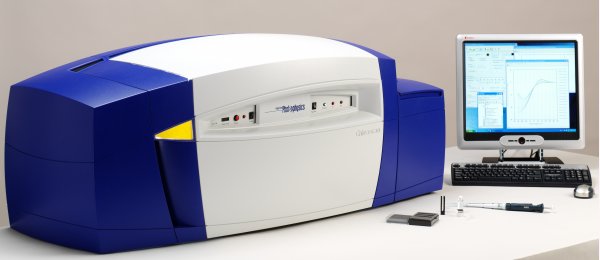Chirascan V100

Location - Britannia 107
For enquiries, please contact - Dr. Karin Smorodinsky-Atias
The information provided in this section is taken from “Chirascan V100 User Manual” by Applied Photophysics and "How to study proteins by circular dichroism". Kelly, S.M., T.J. Jess, and N.C. Price, Biochim Biophys Acta, 2005. 1751(2): p. 119-39.
Buffer selection
Buffers for CD measurements need to be carefully selected, to prevent masking of the sample signal (particularly for measurements in the far-UV).
As a rule of thumb, aim for the lowest buffer concentration possible, that will still provide a suitable environment for your sample.
-
Use reagents of the highest purity possible.
-
Filter the sample and buffer using a 0.2 µm filter.
-
Spin the sample prior to analysis, to remove aggregates.
Note – Measure the concentration of your sample after performing these steps!
Avoid buffers containing CD-active compounds:
-
Imidazole
-
Denaturing agents (Urea, Guanidine-HCl)
-
Reducing agents (β-mercaptoethanol, DTT)
-
Sugars
-
EDTA
-
High salt concentrations (especially chloride ions)
-
HEPES, MOPS, MES and PIPES
Note – If your sample buffer contains high concentrations of these compounds, perform buffer-exchange or dialysis to a more suitable buffer.
Make sure to measure the appropriate blank (the exact buffer at the same wavelengths), and subtract it from your sample spectra.
Optical pathlength selection
For far-UV region (<260 nm), use 0.5 to 1 mm path length cuvettes.
-
Water and aqueous buffers absorb strongly in this region, and short path length cuvettes are used to minimize buffer absorbance.
For near-UV region (>260 nm), use 5 to 10 mm path length cuvettes.
-
Longer path lengths are preferable to account for the lower signal that can be expected in this wavelength range.
Optimal absorbance
The total absorbance of the sample and buffer should be in the range of 0.4 – 1.6, to increase the S/N ratio as much as possible.

If the total absorbance is outside the desired range, perform the following steps to adjust it:
-
Change the sample concentration
-
Change the buffer concentration or composition
-
Change the pathlength of the cell

